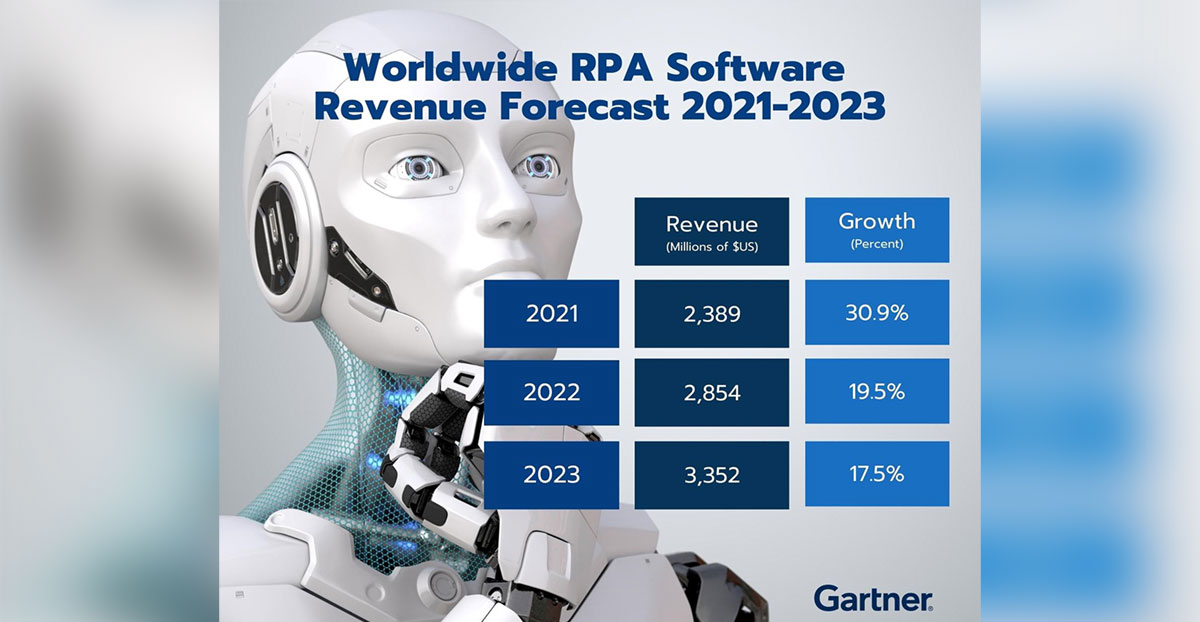RPA Vendors Embrace Hyperautomation-Enabling Technologies for Growth
Global robotic process automation (RPA) software revenue is projected to reach $2.9 billion in 2022, an increase of 19.5% from 2021, according to the latest forecast from Gartner, Inc.
“By achieving a growth rate of 31% in 2021, the RPA market grew well above the average worldwide software market growth rate of 16%,” said Cathy Tornbohm, distinguished VP analyst at Gartner. “Organizations are leveraging RPA to accelerate business process automation initiatives and digital transformation plans, linking their legacy nightmares to their digital dreams to improve operational efficiency.”
Although growing at a slower pace than previous years, the worldwide RPA software market is projected to continue to experience double-digit growth in 2023, growing 17.5% year over year (see Table 1).
Table 1. Worldwide RPA Software Revenue Forecast (Millions of U.S. Dollars)
 “RPA companies are rapidly evolving to provide a wider set of larger automation platforms. Organizations will look to increase their spending on RPA software solutions because they still have a lot of repetitive, manual work that through automation could free up employees’ time to focus on more strategic work,” said Varsha Mehta, senior market research specialist at Gartner.
“RPA companies are rapidly evolving to provide a wider set of larger automation platforms. Organizations will look to increase their spending on RPA software solutions because they still have a lot of repetitive, manual work that through automation could free up employees’ time to focus on more strategic work,” said Varsha Mehta, senior market research specialist at Gartner.
Competitive RPA vendors and many software vendors are pushing beyond a traditional single technology-focused offering to a more advanced suite of tools that encompasses low-code application platforms, process mining, task mining, decision modeling, iPaaS, computer vision, and IDP capabilities on top of their existing RPA offering. This makes them poised to offer, an all-encompassing hyperautomation-enabling technology platform.
In fact, Gartner predicts that through 2024, the drive toward a state of hyperautomation will drive organizations to adopt at least three out of the 20 process-agnostic types of software that enable hyperautomation.
Regional Perspective
North America, Western Europe and Japan together are on pace to account for 77% of global RPA revenue market in 2022. North America will account for the largest revenue share at 48.5%, followed by Western Europe and Japan at 19% and 10%, respectively.
Gartner clients can read more in “Forecast: Enterprise Infrastructure Software, Worldwide, 2020-2026, 2Q22 Update”.
โดยผู้จัดจำหน่าย RPA ต่างเปิดรับเทคโนโลยี Hyperautomation สร้างการเติบโต
การ์ทเนอร์คาดการณ์รายได้ตลาดซอฟต์แวร์ RPA (Robotic Process Automation) ทั่วโลกปี 2565 จะแตะ 2.9 พันล้านดอลลาร์สหรัฐฯ เพิ่มขึ้น 19.5% จากปี 2564
เคธี่ ทอนโบห์ม รองประธานฝ่ายวิเคราะห์ของการ์ทเนอร์ กล่าวว่า “จากอัตราการเติบโตของตลาด RPA ในปี 2564 ที่สูงถึง 31% ทำให้การเติบโตของซอฟต์แวร์กลุ่มนี้เติบโตเหนือกว่าตลาดซอฟต์แวร์ทั่วโลกเฉลี่ยที่ 16% ซึ่งองค์กรต่าง ๆ กำลังนำประสิทธิภาพของ RPA มาใช้เพื่อเร่งพัฒนากระบวนการทางธุรกิจให้เป็นระบบอัตโนมัติและสร้างแผนการเปลี่ยนแปลงทางดิจิทัล เชื่อมต่อเข้ากับระบบเดิมเพื่อปรับปรุงประสิทธิภาพการดำเนินงาน”
แม้ว่าการเติบโตของตลาดในปีนี้จะช้ากว่าปีก่อน แต่คาดว่าตลาดซอฟต์แวร์ RPA ทั่วโลกจะยังเติบโตในระดับเลขสองหลักในปี 2566 หรือเติบโตเฉลี่ยที่ 17.5% ต่อปี (ดูตารางที่ 1)
ตารางที่ 1. คาดการณ์รายได้ตลาดซอฟต์แวร์ RPA (หน่วย: ล้านดอลลาร์สหรัฐฯ)

วาร์ชา เมห์ตา ผู้เชี่ยวชาญอาวุโสฝ่ายวิจัยการ์ทเนอร์ กล่าวว่า “บริษัทซอฟต์แวร์ RPA กำลังเร่งพัฒนาบริการอย่างรวดเร็ว เพื่อนำเสนอแพลตฟอร์มระบบอัตโนมัติขนาดใหญ่ขึ้นโดยองค์กรต่าง ๆ จะให้ความสนใจและเพิ่มการใช้จ่ายในโซลูชันซอฟต์แวร์ RPA เนื่องจากยังมีงานแบบแมนนวลประเภทที่ต้องทำซ้ำ ๆ อีกมาก ซึ่งระบบอัตโนมัติจะช่วยทำให้พนักงานได้ใช้เวลาอย่างคุ้มค่าและมุ่งเน้นไปยังงานเชิงกลยุทธ์ได้มากขึ้น”
บริษัทที่แข่งขันอยู่ในตลาด RPA และบริษัทด้านซอฟต์แวร์อื่น ๆ กำลังมุ่งผลักดันการให้บริการที่เหนือกว่าแค่การเน้นเทคโนโลยีเดียวแบบเดิม ๆ ไปสู่ชุดเครื่องมือขั้นสูงที่พัฒนาขึ้นโดยโลว์โค้ดแอปพลิเคชันแพลตฟอร์ม (Low-Code Application Platform), เหมืองกระบวนการ (Process Mining), การทำเหมืองข้อมูลที่ช่วยให้ธุรกิจสามารถบันทึกข้อมูลการโต้ตอบของผู้ใช้ได้ (Task Mining) การสร้างแบบจำลองการตัดสินใจ (Decision Modeling), iPaaS(Integration Platform as a Service)บริการเชื่อมต่อหลาย ๆ ระบบเข้าด้วยกันเพื่อให้เป็นอัตโนมัติ, เทคโนโลยี Computer Vision (แขนงหนึ่งของวิทยาการปัญญาประดิษฐ์หรือ AI) และการจัดทำแผนพัฒนารายบุคคล (หรือ IDP) เสริมเข้าไปในระบบ RPA ที่มีอยู่เดิม สิ่งเหล่านี้ทำให้ผู้ให้บริการ RPA มีความพร้อมนำเสนอแพลตฟอร์มเทคโนโลยีที่ห้อมล้อมไปด้วยระบบ Hyperautomation ที่ครอบคลุมทุกอย่าง
การ์ทเนอร์ คาดการณ์ว่าจากนี้ไปจนถึงปี 2567 ระบบ Hyperautomation จะเป็นเทคโนโลยีขับเคลื่อนสำคัญที่ผลักดันให้องค์กรหันมาปรับใช้ซอฟต์แวร์ที่ให้ความแตกต่างกันในกระบวนการที่เปิดใช้งานไฮเปอร์ออโตเมชั่นอย่างน้อย 3 จาก 20 ประเภท
เปิดมุมมองในระดับภูมิภาค
อเมริกาเหนือ ยุโรปตะวันตก และญี่ปุ่น มีสัดส่วนของรายได้ RPA อยู่ที่ 77% ของรายได้ RPA ทั่วโลกทั้งหมดในปี 2565 โดยอเมริกาเหนือจะมีส่วนแบ่งรายได้สูงสุดที่ 48.5% ตามมาด้วยยุโรปตะวันตกและญี่ปุ่นที่ 19% และ 10% ตามลำดับ
 “RPA companies are rapidly evolving to provide a wider set of larger automation platforms. Organizations will look to increase their spending on RPA software solutions because they still have a lot of repetitive, manual work that through automation could free up employees’ time to focus on more strategic work,” said Varsha Mehta, senior market research specialist at Gartner.
“RPA companies are rapidly evolving to provide a wider set of larger automation platforms. Organizations will look to increase their spending on RPA software solutions because they still have a lot of repetitive, manual work that through automation could free up employees’ time to focus on more strategic work,” said Varsha Mehta, senior market research specialist at Gartner.
